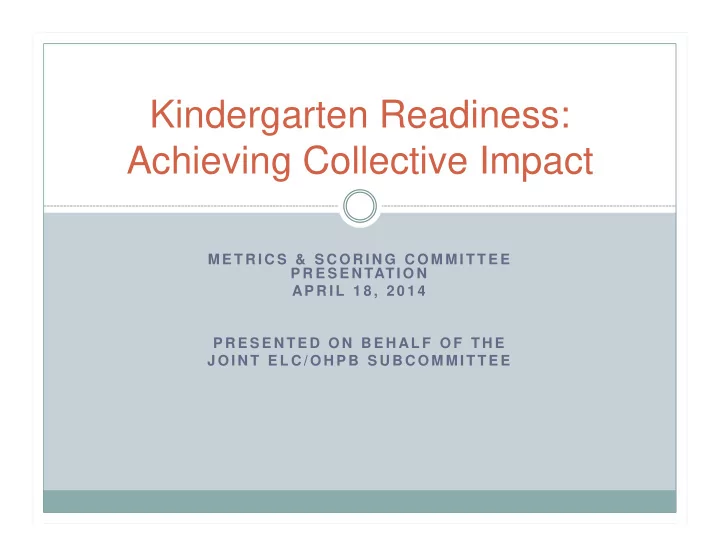

Kindergarten Readiness: Achieving Collective Impact M E T R I C S & S C O R I N G C O M M I T T E E P R E S E N TAT I O N AP R I L 1 8 , 2 0 1 4 P R E S E N T E D O N B E H AL F O F T H E J O I N T E L C / O H P B S U B C O M M I T T E E
Today � Evidence for Early � Collective Impact � Oregon’s Kindergarten Assessment � Kindergarten Readiness as CCO Measure � Discussion
Evidence for Early � Critical aspects of brain architecture are established before and soon after birth � Experiences during sensitive periods of development are exceptionally important in shaping capacities of the brain and other vital organs � Early experiences drive health and education outcomes
Early Matters Genetics + Environment + Experience = Life Trajectory
In Oregon � 45,000 children born each year � 315,000 ages 0-6 � 40% at risk (n=~120,000) � $380+ million per year focused on prevention � $1.7 billion per biennia on young children/families � Opportunity for better return on investment
Achieving Shared Goals Health System Early Learning System Healthy Children = Ready Children ���������������������� ������������� � � ����������� � � ������������������������ � ������������������� � �����������
Collective Impact � The commitment of a group of important actors from different sectors to a common agenda for solving a specific social problem � Our transformational goals cannot be achieved alone! � Triple Aim, Kindergarten Readiness � Necessary for Collective Success: � Common Agenda � Shared Measurement Systems � Mutually Reinforcing Activities � Incentives for collective action… John Kania & Mark Kramer , Collective Impact, Stanford Social Innovation Review, Winter 2011
Kindergarten Readiness as a Shared Measure Across Health and Early Learning � A true primary prevention strategy � Catalyst for our collective impact strategies � Move from measuring process � outcome � Transformational
Oregon’s Kindergarten Assessment � Early Literacy (direct assessment) � Letter names � Letter sounds � Early Math (direct assessment) � Numbers and operations � Approaches to Learning (observational assessment) � Child Behavior Rating Scale
What the Data Show � 1/3 of entering kindergartners could name 5 or fewer letters � 1 in 7 children couldn’t name any letters � Over 1/3 couldn’t identify a single letter sound � One quarter of all entering kindergartners did not regularly demonstrate skills like completing tasks and following directions
Using the Data: A Look Back and a Look Forward State Level Data help Hubs and CCOs measure progress over Community time Data help measure progress over time Health/Early Schools : Learning : Data inform Data help Data help target Data inform classroom target local supports, program and instruction resources strategies and practice interventions
Collective Impact Strategies � Shared developmental screening efforts � Connecting to appropriate services; coordination of care � Implement screening in prenatal settings � Mental/behavioral/social health screening tools, connection to resources � Expand evidence-based early literacy programs in primary care settings � Reach Out and Read � Support a coordinated system of home visiting � Innovative use of TCM dollars in CCO global budget � Care coordination � CCO/Medical Home/Early Learning Hubs � Innovations: developmental origins of health and disease (DOHaD) � Role of nutrition and stress in preconception/prenatal period
Phased Approach: Measuring Kindergarten Readiness 2016 2014 Measurement Year for Report State and CCO Incentive CCO Baseline Measure 2015 • Adopt KR as CCO Incentive Measure for 2016 • Establish benchmark targets from 2014 baseline
Investment in Early Childhood The evidence is quite clear: early health and early childhood development from birth to age 5 is a form of preventive health and economic investment that drives achievement and economic returns. Gabriella Conti and James J. Heckman, Investing in What Works for America’s Communities
Questions Pam Curtis Director, Center for Evidence-based Policy Chair, Early Learning Council curtispa@ohsu.edu Dana Hargunani Child Health Director, Oregon Health Authority Staff, Joint ELC/OHPB Subcommittee dana.hargunani@state.or.us David Mandell Special Advisor on Early Childhood Speaker of the House Tina Kotek david.mandell@state.or.us
Recommend
More recommend